Recent Articles
Popular Makes
Body Types
2014 Nissan Pathfinder Review and Quick Spin
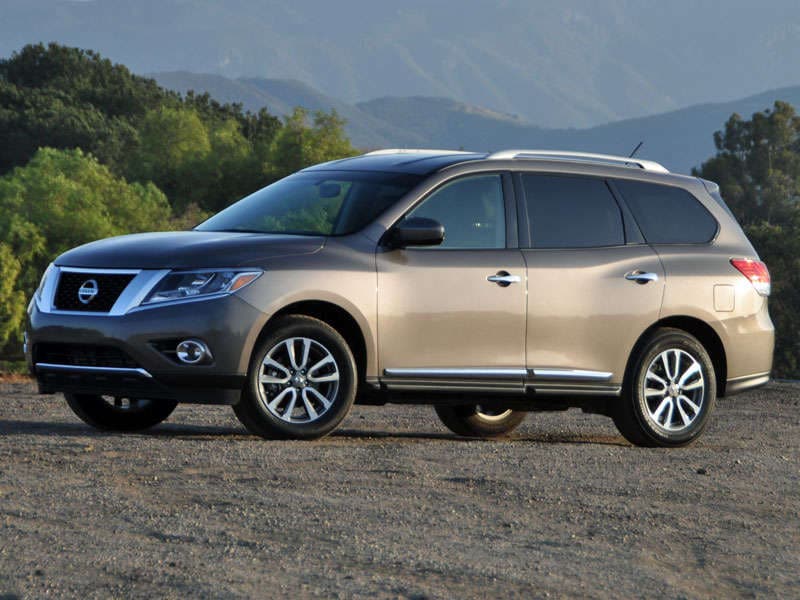
2014 Nissan Pathfinder SL 4WD Mocha Stone Paint Front Quarter Left ・ Photo by Christian Wardlaw
In my family, I’m the pudgy city boy, and my brother is the fit outdoorsy type. My garage contains an immaculate Nissan Murano. His garage holds a beat-up Nissan Pathfinder. Despite their advancing ages, neither SUV has required a major repair. And yet, neither of us wants to replace our respective vehicles with a 2014 Nissan Pathfinder.
My wife, drawn to the first-generation Murano’s avant-garde styling, has her eye on the unusual Ford Flex. His wife, drawn to the previous-generation Pathfinder’s rugged styling, wants a Jeep Wrangler Unlimited. I’d bet this is not the reaction Nissan intended with the Pathfinder’s latest redesign, and at the same time it is clear that the rest of America doesn’t feel the same way as my family members do.
The current iteration of the Pathfinder went on sale for the 2013 model year, transforming it from an off-road-ready SUV easily worthy of its name, into a bigger, plusher, 7-passenger crossover most adept at finding paths to local malls and school pick-up lines. What happened? Pathfinder sales doubled in the first year.
Having now spent a week driving a 2014 Pathfinder SL with all-wheel drive, I totally understand why most people prefer this to the cramped, harsh-riding, gas-slurping Pathfinder my brother owns. Going from that to this is like upgrading from a Nissan Sentra to an Infiniti Q50. In other words, there’s plenty to like about this big Nissan, but glaring omissions could be deal-breakers, especially considering the Pathfinder’s new family-friendly mission.
2014 Nissan Pathfinder Review and Quick Spin: About Our Test Car
In addition to offering a new Pathfinder Hybrid this year, Nissan installs a new Tech Package option for the Pathfinder SL trim level, and that’s exactly how my 4-wheel-drive test vehicle was configured. The Tech Package ($1,570) adds a hard-drive navigation system with voice recognition technology and an 8-inch color display screen, a muddy-sounding 13-speaker Bose audio system, a free 3-month subscription to satellite traffic and weather information, and more. Add a Trailer Tow Package ($400 – tow hitch receiver, trailer harness) and a set of carpeted floor mats ($210) to my Pathfinder SL 4WD model’s base price of $37,710, and the window sticker rose to $39,860.
You don’t need to spend that much for a Pathfinder, though. Prices range from less than $30,000 for the base Pathfinder S with front-wheel drive to just over $46,000 for a Pathfinder Platinum Premium 4WD with all the bells and whistles.
Before you run out and buy a new Pathfinder, though, there’s something you should know. You can get a certified-used Infiniti JX35 (now called the QX60) for the same money, and the Infiniti is basically the same thing but with more appealing styling, a more upscale and luxurious interior, upgraded safety features, and more.
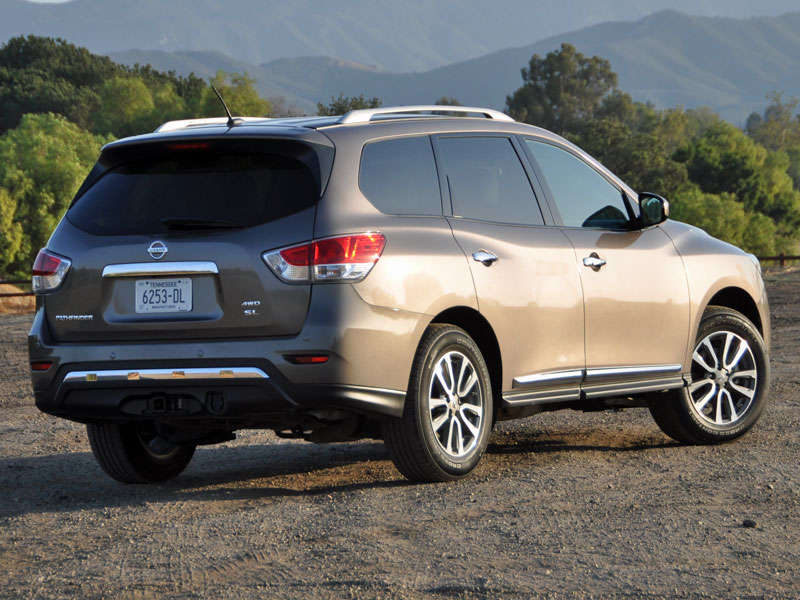
Photo by Christian Wardlaw
2014 Nissan Pathfinder Review and Quick Spin: Styling and Design
If you like the way the Nissan Pathfinder looks, you’re probably going to like almost everything else about this SUV. Me? I’m not a fan.
Aside from my test vehicle’s Mocha Stone paint, appealing primarily for its ability to conceal dirt, the main reason I don’t like the Pathfinder’s styling is the drooping character line that sweeps down off the hood and makes the SUV look puffy-fendered and top-heavy. Also, the SL model’s undersized 18-inch aluminum wheels are identical to the ones on the base S model; to get nicer 20-inch wheels, you’ve gotta buy one of the pricey Pathfinder Platinum models.
I’m equally unimpressed by the Pathfinder’s drab interior materials. The cabin is aesthetically pleasing, but much of it is covered in hard, shiny plastic, and I haven’t seen simulated wood this obviously fake since my father bought a new 1977 Ford Thunderbird.
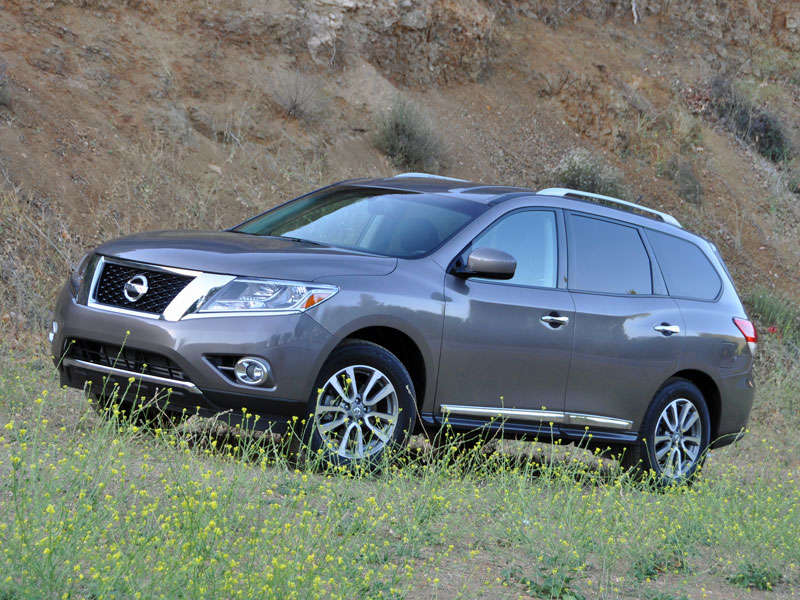
Photo by Christian Wardlaw
2014 Nissan Pathfinder Review and Quick Spin: Comfort and Cargo
There’s no question that the Nissan Pathfinder is roomy, and it’s easy to get into and out of, too. Once you’re situated behind the wheel, the Pathfinder SL promises decent long distance comfort as long as you don’t mind the stiff and dry leather, or the fact that ventilated seats are available only on the Platinum models.
Front-seat passengers might not be as happy, because no matter how money you have to spend on a Pathfinder, you can’t get a height adjustable front passenger’s seat. Personally, I didn’t like sitting on that side of the SUV due to the lack of thigh support.
Rear-seat passengers are offered a greater degree of control over their comfort, thanks to the standard EZ Flex seating, which slides in tracks to maximize legroom depending on the situation. If you’re not using the third-row seat, slide the second-row seat all the way back to maximize legroom and comfort. If you need to add passengers, slide it forward to improve third-row space. Even with the second-row seat moved all the way forward, I fit into this SUV, which means the Pathfinder can carry seven full-size adults when necessary.
Thanks to what Nissan calls a Latch ‘N Glide system, which moves the right portion of the second-row seat well out of the way, it is easier to load and unload third-row seat passengers. You can even use it with a child seat installed in the second-row outboard seating position.
Like most third-row seats, though, the bottom cushion is low and flat, and comfort isn’t good for adults. Nissan also says the third-row seats recline, but that just puts your head closer to the back window, making it more vulnerable in a rear-impact collision. Don’t do that.
Get the Pathfinder SL model, and it comes with a standard power tailgate. Personally, I don’t like ‘em, because sometimes you just want to yank it open and duck under to get out of the weather. Where I evaluate vehicles in California, though, I just impatiently tap my foot and wait.
Once the tailgate is open, you’ve got choices. Use the third-row seat, and you’ll be left with 16 cubic-feet of space stacked to the roof, about as much as an Altima sedan. Fold the third-row seat, and the Pathfinder holds five people plus a minimum of 42.4 cu.-ft. of cargo, depending on how the sliding second-row seat is positioned. Maximum cargo hauling capacity measures 79.8 cu.-ft., which sounds impressive until you consider that the smaller Nissan Rogue can handle up to 70 cu-ft. of stuff.
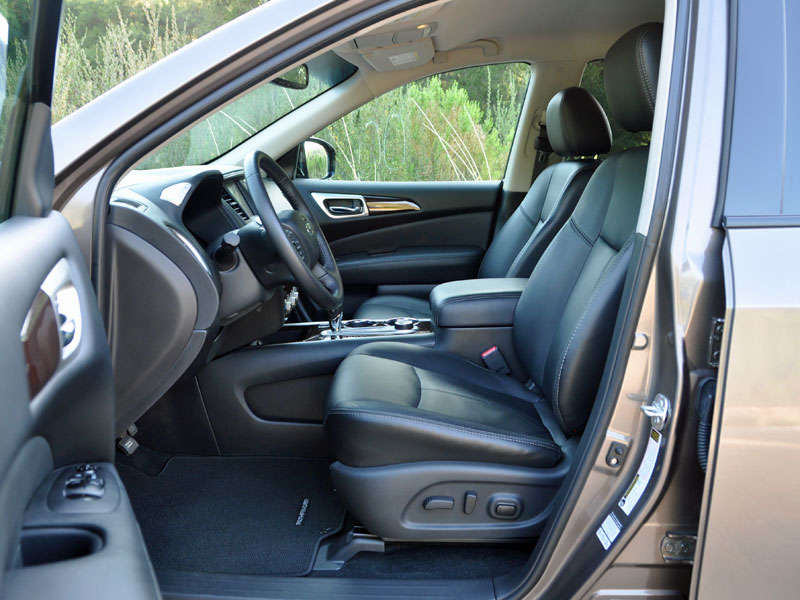
Photo by Christian Wardlaw
2014 Nissan Pathfinder Review and Quick Spin: Features and Controls
Nissan does a good job of arranging the Pathfinder’s controls, as well as making it obvious as to what they do. In almost every situation, you’ll find what you’re looking for, and right where you expect to find it.
One thing I really like about the Pathfinder is that it supplies buttons and knobs for all of the primary stereo and climate control functions, limiting my interaction with the touchscreen display. Once you’ve got this SUV set up the way you want it, the touchscreen is mainly a reference point rather than a tool.
Storage areas are plentiful, too, including a big glove box, sizable cupholders, a decent center storage console, and numerous slots, trays, and bins.

Photo by Christian Wardlaw
2014 Nissan Pathfinder Review and Quick Spin: Safety Matters
If there’s an aspect of the 2014 Nissan Pathfinder requiring immediate improvement, it is in the area of safety features and technology. To get a reversing camera, you’ve gotta buy the Pathfinder SV ($33,160) at a minimum. The Pathfinder Platinum ($40,810) adds an Around View Monitor with 4 different cameras that are designed to give you an overhead, 360-degree view of the SUV and its surroundings in order to make parking easier. You can even check a camera view to see how close you are to the curb.
Now, you’d think Nissan might be able to aim one of those cameras to provide a blind-spot information system, or a lane departure warning system, or a forward collision warning and braking system, or a rear cross-traffic alert system, but none of these increasingly useful safety technologies is offered for the 2014 Pathfinder, at any price.
Upgrade to the Infiniti QX60, which is based on the Pathfinder (it was the JX35 in 2013), and you can get all of these features and more. Honestly, I’m not cool with that. Pay to play is understandable, because these technologies aren’t cheap, but in my opinion, families should not be required to upgrade to the luxury brand in order to access useful safety equipment.
If you decide to move forward with the Pathfinder, know that it gets a 5-star overall crash test rating from the National Highway Traffic Safety Administration (NHTSA). For whatever reason, the good people at the Insurance Institute for Highway Safety (IIHS) have not performed full testing on the Pathfinder, but this SUV gets the top rating of “Good” in the moderate overlap frontal-impact and side-impact tests.
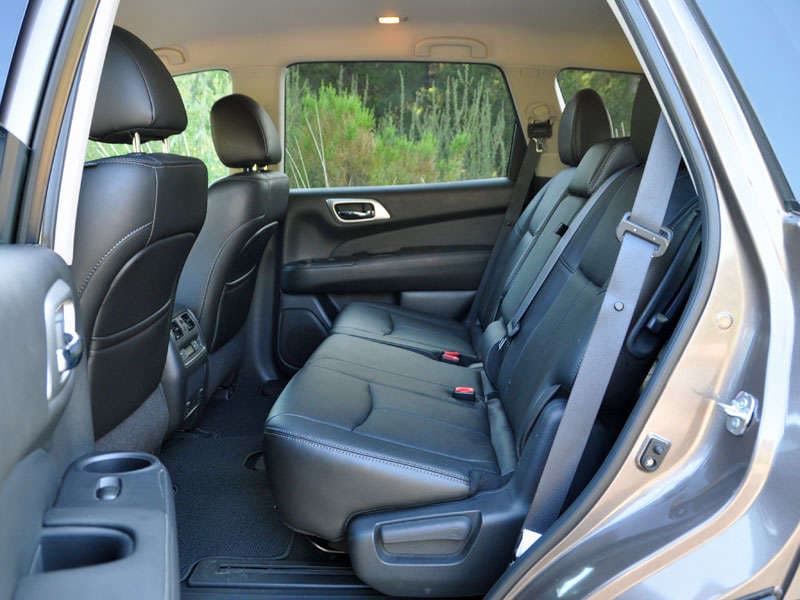
Photo by Christian Wardlaw
2014 Nissan Pathfinder Review and Quick Spin: Driving Impressions
Though Nissan now sells the 2014 Pathfinder Hybrid, which pairs a supercharged 4-cylinder engine with an electric assist motor powered by a lithium-ion battery in order to generate 250 horsepower and 26 mpg in combined driving, I wanted to evaluate the version everybody buys, the one with the 260-horsepower V-6 engine and the continuously variable transmission (CVT).
A CVT is designed to optimize power output and fuel economy at all times, and Nissan has been using this type of transmission for more than a decade. As a result, the company has gotten really good at building CVTs, and if I hadn’t just told you the Pathfinder’s got one, you might not have guessed otherwise.
Anyway, while driving around Los Angeles with my family aboard, the Pathfinder proved plenty energetic, and I averaged 19.1 mpg. That’s less than the EPA’s estimate of 21 mpg in combined driving, and much less than the Pathfinder Hybrid’s 26-mpg rating.
Though it looks soft and pudgy from the outside, the Nissan Pathfinder exhibits a taut and athletic driving character. The V-6 is smooth and eager to rev, and the CVT makes best use of the power, instantly switching to an appropriate ratio as the driver applies or releases the accelerator pedal. I had no trouble leading traffic away from stoplights, merging onto freeways, or ascending mountains.
The Pathfinder is big, and feels that way from the driver’s seat, but I found it easy to drive in heavy city traffic and when parking in cramped lots. A tall driving position sure helps, and the Pathfinder’s suspension tuning makes the SUV feel nimbler than expected. The trade-off is a firm ride – occupants definitely know what’s happening at the road surface – but I prefer the Pathfinder’s stiffer, better-controlled setup to a mushy ride and wallowing in corners.
Handling is decent, too, though the 18-inch tires squeal easily. And I had no complaints about the brakes, which are easy to modulate and work well, even when abused. Lots of road noise makes its way into the cabin, though, especially when driving on imperfect surfaces.
Nissan needs to fine-tune the Pathfinder’s electric steering, and this has been a complaint of mine about several recent Nissans I’ve driven. In my opinion, Nissan programs the electric steering with too much off-center resistance, combined with a strong tendency to return to center. As a result, the driver feels like he or she is constantly fighting the steering wheel, and the SUV wavers when rounding higher-speed constant radius turns, like freeway flyover ramps. And if you hit a dip while rounding a curve, one that loads and then unloads the weight over the front tires, the wavering gets even worse.
I did subject the Pathfinder to a bit of light off-roading, confirming that the SUV’s shallow approach and departure angles, combined with a lack of ground clearance and wheel articulation, prevent it from getting too far off the pavement. Stick to battling snowstorms in the suburbs, and you’ll be using the Pathfinder in the way Nissan intends.
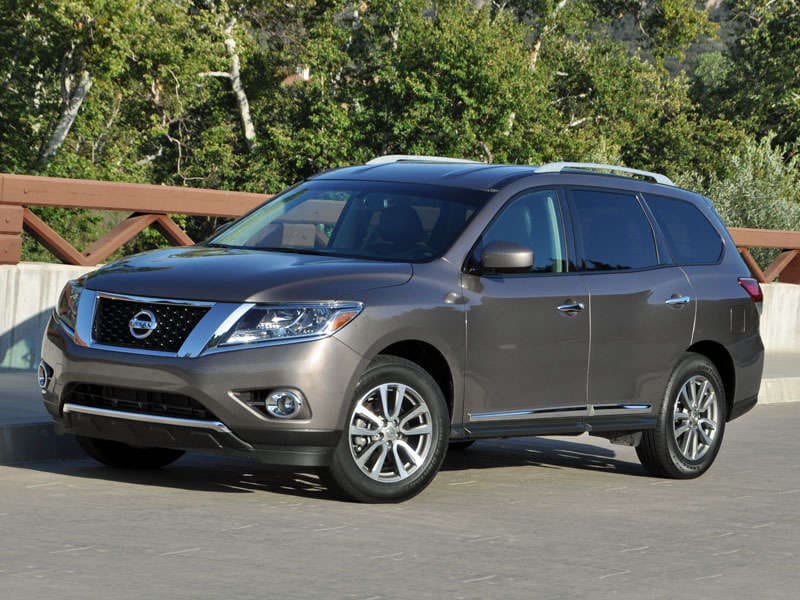
Photo by Christian Wardlaw
2014 Nissan Pathfinder Review and Quick Spin: Final Thoughts
With the latest Nissan Pathfinder, the company builds what SUV buyers want, transforming the icon from a rugged go-anywhere, do-anything SUV into a minivan disguised as an SUV. As a result, sales have doubled, and now that I’ve spent a week shuttling my own family in the Pathfinder, I get it. I’m not really happy about it, but I get it.
Where Nissan needs to improve the Pathfinder is with regard to safety features. More of them, available on lower levels of trim, is an absolute necessity. Competitors are mopping the floor with Nissan on this front, and if the reason for not offering safety gear is to preserve exclusivity for the Pathfinder-based Infiniti QX60, it’s a poor one.
Nissan provided the 2014 Pathfinder SL for this review
2014 Nissan Pathfinder SL photos by Christian Wardlaw
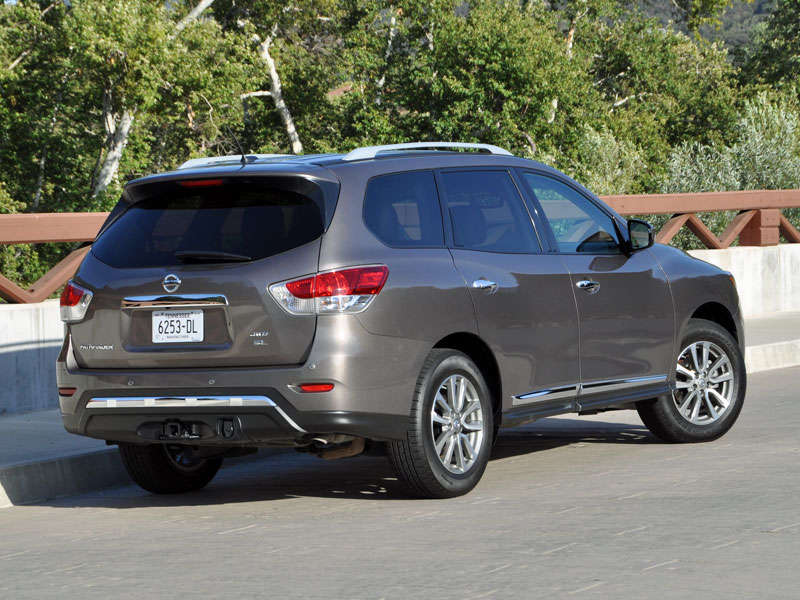
Photo by Christian Wardlaw